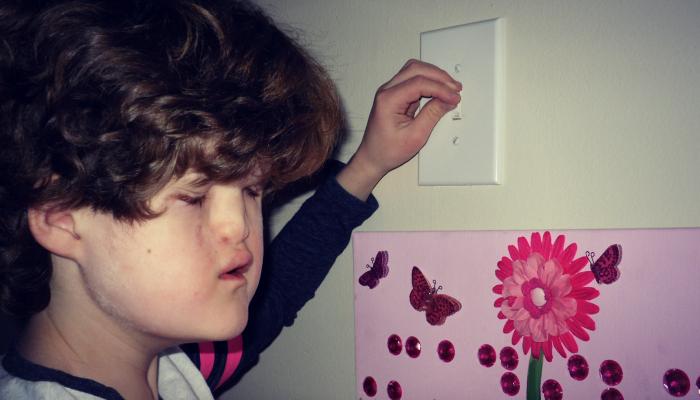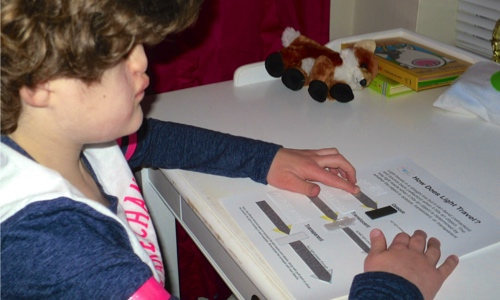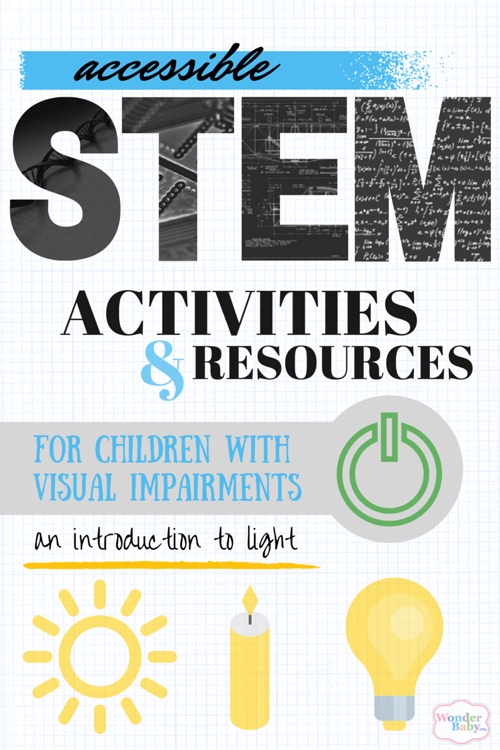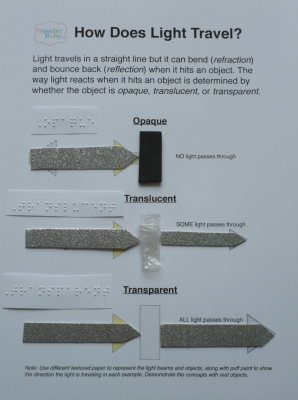Accessible STEM: An Introduction to Light for Blind Children

Why Does Someone Who Can’t See Need to Know About Light?
Because it exists! A child with visual impairments should always have the opportunity to explore the concepts behind everything to which a child with sight is exposed, with special attention focused on the fundamentals that are often picked up naturally through visual cues. A child that has been blind since birth may never experience light and vision the same way as someone with some or all of their sight, but that doesn’t mean he can’t understand the basic sciences of light and how it is referred to in everyday life.
A Blind Child’s Experience with Light
Your child has probably heard you talking about turning the lights “on” and “off” in the house or commenting on the bright sun shining outside on a pretty day. These are common references to light brought up on a daily basis.
I have memories of my daughter Madilyn (blind since birth with bilateral anophthalmia) finding the light switch on the wall, flipping it up and down as she questioned its use, “What does this do?” to which I replied simply, “It turns the overhead light on and off.” She played with it for a bit longer before accepting the fact that it made no difference to her whether it was flipped up or down. Another time she was sitting near the window and happened to move her hand out of the sunbeam where it had been sitting long enough to become warm. I sat back quietly smiling while a sense of wonder came across her face as she purposely moved her hand back and forth from the shadows to feel the warmth of the sunlight come and go. After a little while, I asked her about it and explained that what she felt was the energy from the sun streaming in through the window. These simple facts were enough to fill her curiosity at the time, but as she’s grown older, I’ve struggled with explaining that there is also light that can be seen, but not felt. When I used basic scientific facts to describe how light works, she was able to understand the concepts using tactile pictures and memorizing key words.

Introduction to the Science of Light
There are a few basic facts that are beneficial to learn. First, what exactly is light?
- Light is a form of energy detected by the sense of sight and makes things visible.
- Light can be different colors, and the absence of light is what we refer to as the “dark.”
- Light travels in a straight line but can be reflected and bent in certain conditions.
- Opaque, translucent, and transparent are words that describe how objects make light’s path change, or not.
Take a moment together to explore your home and other places your child is familiar with like your car and the yard. Be sure to allow him or her time to use his hands and other senses to examine different objects and areas safely as you give verbal descriptions. Discuss whether they give off any light and be sure not to leave out things that are out of reach like the sun and stars, and overhead lights that use a wall switch. Download a PDF worksheet for this activity here.
Make a worksheet using textured paper and puff paint to create raised line images to show how light travels. Encourage children to explore the worksheet through touch and ask questions about colors or how light interacts with familiar objects like his teddy bear or bedroom door. You can download a template for this light worksheet and see an example of the worksheet with textures added below. You can also click here for a larger version of this image so you can see the details.
By exploring real examples in your child’s environment at home, school, and outdoors, he or she will be able to begin to comprehend the idea of light and use its common language socially with his/her sighted peers. Teachers can promote this type of inclusion in the classroom by using the same language and verbal descriptions with all students.
You can find more accessible STEM activities for children with visual impairments on the Perkins eLearning Website, or adapt your own ideas with help from the WonderBaby Math & Science Activities Pinterest Board.
Read this article in Spanish: Lea este articulo en Español
Read this article in Arabic: حيوا-السيدة-العمياء

Related Posts

Eye Conditions and Syndromes, Visual Impairment
Neuralink Announces Plans to Restore Sight to the Blind with Brain Chip
Elon Musk’s company Neuralink has announced plans to begin human trials of its new “Blindsight” brain chip by the end of 2025.

Visual Impairment
The Gift of Understanding: How a Young Child Helps His Blind Father Navigate Life
When a parent is blind, it’s natural for people to wonder how their sighted child will adapt. Will they struggle to understand their parent’s needs? Will they feel burdened by...

Braille and Literacy, Toys, Visual Impairment
24 Braille Toys for Kids Who are Blind
Everything from alphabet blocks to raised line coloring pages and activity books to puzzles to card and board games... and so much more! And it's all in braille ready for...
